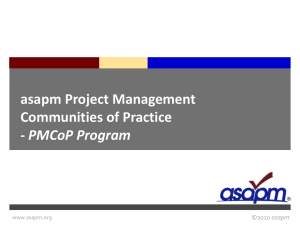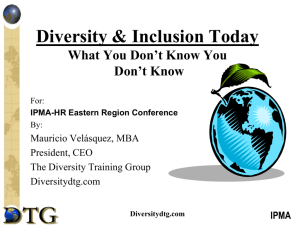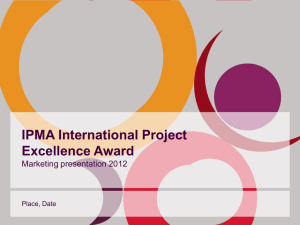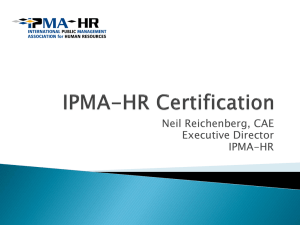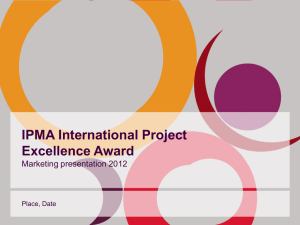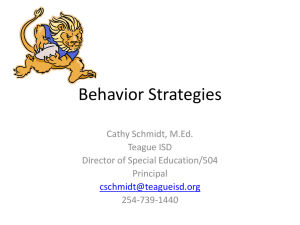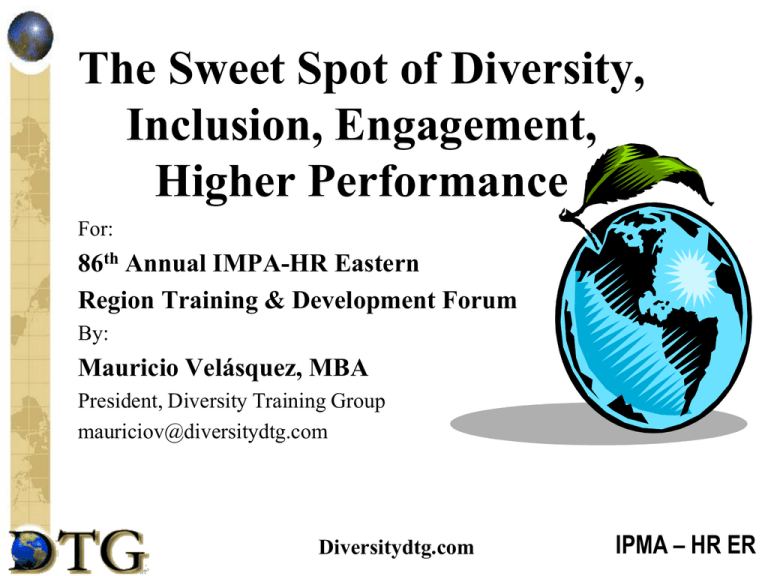
The Sweet Spot of Diversity,
Inclusion, Engagement,
Higher Performance
For:
86th Annual IMPA-HR Eastern
Region Training & Development Forum
By:
Mauricio Velásquez, MBA
President, Diversity Training Group
mauriciov@diversitydtg.com
Diversitydtg.com
IPMA – HR ER
Meet Mauricio Velásquez
Mauricio Velásquez is the President and CEO of The
Diversity Training Group (DTG) in Herndon, VA. Mauricio
serves as a diversity strategy consultant, diversity trainer,
sexual harassment prevention trainer, executive coach,
mentoring trainer, and expert witness (listed with TASA).
DTG’s clients include small and large federal agencies
including US Navy, USDOJ, NIST, NIH, EPA, ATFE, FCC,
and USCIS. Past federal clients include DOI (BLM, BOR,
BIA), USIA, USDA, US Coast Guard, and even the White
House (previous administration).
Mauricio has trained in every state but North Dakota and
with a recent trip to Guantanamo Bay, Cuba – work and life
has taken Mauricio to over 75 countries.
IPMA – HR ER
Diversitydtg.com
Mauricio’s Mission
Provoke Thought
Facilitate Discussion & Learning
Surprise You
Entertain You
Add Value
Provide Subject Matter Expertise
Diversitydtg.com
IPMA – HR ER
Opening Remark
What You Don’t
Know You Don’t
Know
(DKDK)
What You
Don’t Know
(DK)
What You Know
(K)
Diversitydtg.com
IPMA – HR ER
Intent vs. Impact
Intent
(what you meant)
vs.
Impact
(what you actually said)
Diversitydtg.com
IPMA – HR ER
Diversity
What pops into your head?
What comes to mind?
Diversitydtg.com
IPMA – HR ER
Dimensions of Diversity
Language
Military
Experience
Education
Religion
Age
Gender
Work
Style
Family
Status
Income
Sexual
Orientation
Ethnic
Heritage
Mental/
Physical
Abilities
Race
Work
Experience
Individual
Geographic
Location
Communication
Style
Operational Role
and Level
Group
Organizational
Affiliation
Diversitydtg.com
IPMA – HR ER
Dimensions of Diversity
Military
Experience
Language
Education
Religion
Work
Style
Age
Gender
Income
Mental/
Physical
Abilities
Sexual
Orientation
Family
Status
Ethnic
Heritage
Work
Experience
Race
Communication
Style
Geographic
Location
Operational Role
and Level
Diversitydtg.com
IPMA – HR ER
Dimensions of Diversity
Indivi
Individual
dual
Group
Organizational
Affiliation
Diversitydtg.com
IPMA – HR ER
To Be Inclusive
To welcome “all”
To include
To make comfortable
When included – you become “fully
engaged” in your work
Diversitydtg.com
IPMA – HR ER
Engagement – one way of looking at it
With Organization
(trust)
With Manager
(feel valued)
High
Performance
Strategic Alignment
(clear goals, strategy)
Diversitydtg.com
Competency
(you got what it
takes)
IPMA – HR ER
Engagement
Fully Engaged
– What does it look like?
Not Engaged
– What does it look like?
Actively Disengaged – What does it look like?
Think of your own team, office, organization
What percentage of your team are
Fully Engaged?
___%
Not Engaged?
___%
Actively Disengaged? ___%
A World Class Organization…
Diversitydtg.com
IPMA – HR ER
Employee Engagement Key to Creating a
World Class Organization
Source: Gallup Consulting
Diversitydtg.com
IPMA – HR ER
The Lunch Date
Adam Davidson
Screen Writer/Director
This was his thesis to get his degree in
film from AFI – American Film Institute,
New York City
Won many awards
Filmed in 1990
Diversitydtg.com
IPMA – HR ER
Did they trust each other?
The two characters
What are we taught about “strangers” – all
cultures
Diversitydtg.com
IPMA – HR ER
At the Center of my work….
TRUST – means confidence
Behind “Diversity and Inclusion” issues I always find Trust
issues”
LEADERSHIP – getting results in a way that inspires trust
There is no “Leadership Without Followership” – Do
diverse followers trust homogeneous leaders?
Please read: SMR Covey’s “The Speed of Trust”
Diversitydtg.com
IPMA – HR ER
Trust & Being World Class – Go Hand in
Hand
Stephen M. R. Covey – in his book: The Speed of
Trust talks about Trust - Taxes and Dividends
When there is high trust – there is an actual
dividend for this trust – tasks, work, progress,
cooperation, collaboration - success is easier
When there is low or nonexistent trust – there is an
actual tax – tasks, work, is harder, indifference,
bogged down, sabotage
I highly recommend you read this book for your
community, for your kids, for your families and
jobs, of course…
Diversitydtg.com
IPMA – HR ER
S.M.R. Covey says….
“The ability to establish, grow, extend, and
restore trust with all stakeholders –
customers/clients, business partners,
coworkers – is the key leadership
competency of the new global economy.”
“Leadership is getting results in a way that
inspires trust.”
In your every action – do you inspire trust,
are you leading by example?
Diversitydtg.com
IPMA – HR ER
“Before You Can Understand
‘Others’ – You Must
Understand Yourself First!”
- MV
Self awareness is so critical!
Diversitydtg.com
IPMA – HR ER
The Winning Balance
So where do I stand? Where am I with respect to this topic? Respond to the
questions below based on your behaviors.
How often do I…
Rarely
Sometimes
Usually
Mostly
Challenge others privately when they make racially,
ethnically, or sexually offensive comments?
1
2
3
4
Challenge others publicly when they are making
fun of others because of their race, gender, ethnic
background, religion, appearance, disability, or
sexual orientation?
1
2
3
4
3.
Think about the impact of my comments and
actions before I speak?
1
2
3
4
4.
Refuse to tell jokes that are derogatory to any
group, culture, or sex?
1
2
3
4
5.
Refrain from repeating statements or rumors that
reinforce prejudice or bias?
1
2
3
4
6.
Avoid generalizing the behaviors or attitudes of one
individual to an entire group (e.g.: “All blacks
are...,” “All disabled people are...,” “All men
are...,”)?
1
2
3
4
1.
2.
Diversitydtg.com
IPMA – HR ER
The Winning Balance (cont.)
How often do I…
Rarely
Sometimes
Usually
Mostly
Accept that I am a biased person and understand
that there will be times when my biases will come
out in my actions or words?
1
2
3
4
Avoid using language that reinforces negative
stereotypes (e.g.: “You’re acting like a pack of wild
Indians,” “Jew them down,” “White of you,” “I’ll
get my girl to do it”)?
1
2
3
4
Learn about people of different races and groups
(through reading, attending voluntary seminars,
watching television specials, listening to speakers)?
1
2
3
4
10. Get to know people of different races and groups
and individuals (make the first effort to talk to
them, invite them to socialize)?
1
2
3
4
11. Support and take responsibility for helping my
organization meet EEO/AA guidelines?
1
2
3
4
12. Value people who are different from me as
resources because of their unique skills, abilities,
perspectives, and approaches?
1
2
3
4
7.
8.
9.
Diversitydtg.com
IPMA – HR ER
The Winning Balance (cont.)
How often do I…
Rarely
Sometimes
Usually
Mostly
13. Work to change policies that disregard different
cultural beliefs or religious holidays?
1
2
3
4
14. Challenge the notion that individuals need to act or
look a certain way to be successful or valuable to
the organization?
1
2
3
4
15. Forgive people who make biased statements about
me or others and allow them to regain my trust and
respect?
1
2
3
4
16. Include and invite people different from myself into
the decision-making process?
1
2
3
4
17. Provide timely and honest feedback to others,
including those different from myself, even if it
feels risky?
1
2
3
4
Diversitydtg.com
IPMA – HR ER
The Winning Balance (cont.)
How often do I…
Rarely
Sometimes
Usually
Mostly
1
2
3
4
19. Disregard physical characteristics (disability,
attractiveness, height, weight, dress, etc.) when
interacting with others and making decisions about
their ability?
1
2
3
4
20. Support organizational policies regarding equal
treatment by confronting people who violate those
policies and reporting them if necessary?
1
2
3
4
18. Share the formal and informal rules of my group
with those different from myself?
Used with permission of Bureau of National Affairs, The Winning Balance.
Diversitydtg.com
IPMA – HR ER
What Your Scores Tell You
0 - 20 Naive
Acts with no knowledge or awareness of biases and
prejudice and their impact on others. What they don’t
know they don’t know. This person has no clue as to the
impact of their actions on others.
21 - 40 Perpetuator Aware of biases and prejudices, but continues behaviors
and actions that reinforce and support stereotypes and
intolerance. This person is aware of the impact of their
actions on others, but continues with such behaviors
nevertheless, “You can’t teach an old dog new tricks.”
41 - 59 Avoider
Aware of biases and prejudices, but makes a conscious
choice to ignore inappropriate behavior or withdraw from
it. This person would rather turn and walk away than
understand and address inappropriate behaviors or that
bias that can appear or be misinterpreted as support. “If
you are not part of the solution, you are part of the
problem.”
Diversitydtg.com
IPMA – HR ER
What Your Scores Tell You
60 - 75 IWE
Change Agent
Acts as a role model. Takes action when appropriate and
addresses behaviors when important. IWE Change Agent
will take risks and use the many tools available to
him/her. IWE Change Agent will take peers aside and
provide feedback and coaching with the intent to improve
work relationships and personal productivity.
76 - 80 Fighter
Attacks all actions and confronts all behaviors. Always
on the lookout for injustice but is often too
confrontational, sometimes in public settings. Although a
very important role, too often these individuals are
labeled as “troublemakers.” If you have this energy, this
fervor, please consider the change agent approach to
problem-solving and inclusivity.
Diversitydtg.com
IPMA – HR ER
D&I Change Agent
What pops into your head?
Diversitydtg.com
IPMA – HR ER
A Change Agent
Leads by example – Role Model, Inclusive, Trustworthy
Sees human beings, build relationships, suspends
judgment (not label/stereotype)
Mindful of biases, prejudices, SFPs – self aware
Coaches – challenges these notions – individually and
organizationally
Problem-Solves
Builds relationships with all (not just people like yourself)
Builds and promotes trust
Acknowledge, identify, and tackle “Diversity Issues”
Diversitydtg.com
IPMA – HR ER
You have a diversity issue when..
..when an issue (i.e., policy or business practice - formal,
informal, internal or external) has a different impact on a
particular group (for example, impact on men vs. women,
black vs. white, American vs. foreigner, urban vs. rural
background, military vs. civilian, – mentoring, training,
assignments, upward mobility, etc.)
..when it happens more frequently to a particular group (for
example, different groups have dramatically different
“numbers” – turnover, terminations, promotions, few or no
role models)
..when it is more difficult for one group to overcome (upward
mobility for a particular group within an organization) (for
example, “glass ceilings”)
Diversitydtg.com
IPMA – HR ER
Ignoring Diversity Issues comes with a cost
A diversity issue exists where the policy or business practice
(formal or informal) has an impact exclusive of difference
(not inclusive of difference). Is there a trend or pattern
(intentional or unintentional)?
Having a diversity issue is not necessarily a bad thing. Doing
nothing about it given you have knowledge of the issue is
where organizations go wrong (negligence). Being in denial
about these issues does not make them go away. Ignorance is
not bliss.
The question is why do we have this issue and how can we take
action to correct it or improve the situation. A D & I Strategy
is put together to “address these issues” or “solve the
problem” or “focus on the lost opportunity.”
Diversitydtg.com
IPMA – HR ER
Some Tools
PERSON
SEPARATE
BEHAVIOR
Diversitydtg.com
IPMA – HR ER
Start Message
Start with a Positive
Please stop_______________________________________
(describe negative/unproductive behavior)
Start_____________________________________________
(describe new, more appropriate/positive behavior)
Continue_________________________________________
(describe ongoing positive behavior)
End with a Positive
Diversitydtg.com
IPMA – HR ER
I-Statement
How do I coach someone when I feel my differences are being held against me?
(Start with a Positive)
When you ___________________, I feel ______________________
(describe behavior)
(impact of behavior)
I would prefer ___________________________________________
(new behavior – more appropriate/productive)
OR
I feel _____________________, when you ____________________
(impact of behavior)
(describe behavior)
I would prefer ___________________________________________
(new behavior – more appropriate/productive)
OR
When I see ______________, it makes me feel ____________________
(describe behavior)
(impact of behavior on you/group)
I would prefer _______________________________________________
(new behavior – more appropriate, more productive)
(End with a Positive)
Diversitydtg.com
IPMA – HR ER
2 Kinds of Behaviors
PREFERS
- Promote respect
- Diversity friendly
- Inclusive
- Promotes trust
NEVERS
- Disrespect
- Bias/prejudice
- Exclusive
- Undermine trust
Diversitydtg.com
IPMA – HR ER
Change Agents are World Class and
Understand the Sweet Spot
To Value
Diversity, To be
Inclusive
To Respect, Value
Others
To Engage, Be
World Class
Diversitydtg.com
To Perform at
Higher Level
IPMA – HR ER
Using Communication to Solve Problems
Step
?
Action
Example
Identify and agree
on the problem
(consensus) Ask the
right questions.
Ask for the facts
Verify the information
Decide what else you need to
know
“Help me understand exactly”
“Let me make sure this is recorded
correctly”
“I will be able to help you better if I
know…”
Conduct problemcause analysis to
identify a specific
problem and its
cause
Restate the problem in simple
terms
Get agreement on the problem
and its importance/impact
“So, the basic issue is…”
“It seems we agree it is important
to fix this because…”
Identify
solutions/alternative
s
Ask what can be done to solve the
problem
Suggest other options for
consideration
Tell them what you can do
“What ideas do you have on how
this can be fixed?”
“In similar situations we have..”
“I really wish we could do exactly
what you suggested. However,
according to…, we must…”
Diversitydtg.com
IPMA – HR ER
Using Communication to Solve Problems
Step
Action
Example
Implement solutions/take
action with the help of the
customer
Ask for their cooperation
Tell them what you will do
Suggest how they can help,
now and the next time
“I’ll need your help to…”
“Here is what I can do…”
“To get this resolved quickly,
I’ll need you to…, and if this
should happen again,
please…”
End with an agreement and a
thank you. Monitor and
follow up on the situation
Summarize what will be done,
and by whom
Thank the customer for
cooperation and help
Promise to follow up to ensure
the solution really worked
“Can I assume that we agree
on…?”
“Thank you for being so
cooperative in helping us to
solve this problem.”
“I will call you in a week to be
sure the situation is resolved.”
Diversitydtg.com
IPMA – HR ER
Action Plan
How can I create an inclusive
work environment?
How can I use what I have
learned in this class in my
organization and beyond?
Diversitydtg.com
IPMA – HR ER
Nationwide Best Practices
Sources:
American Express Benchmark Study
Business Week Special Sessions
The Conference Board Best Practices Publications
Fortune’s Best Practices Lists/Articles
Towers-Perrin North-American Diversity Best Practices
Study
US Department of Labor and other US Government
Studies
Diversitydtg.com
IPMA – HR ER
What is working
– critical success factors
STRATEGIC
I. Visible, supportive and fully-committed senior
leadership
II. Diversity strategy/plan developed & aligned with
organization’s strategic plan
III. Internal and external communications improved
IV. Employee involvement and assessment
V. Recruitment and retention activities improved
VI. Measurement, metrics and follow through emphasized
VII.Constant benchmarking and continuous improvement
of diversity strategy and plan
Diversitydtg.com
IPMA – HR ER
Navy Definition of Diversity
All of the individual attributes and
characteristics of our Sailors and
Civilians that enhance the mission
readiness of the Navy.
Diversitydtg.com
IPMA – HR ER
For more information…
CONTACT:
The Diversity Training Group
692 Pine Street
Herndon, VA 20170
Tel. 703.478.9191
Fax 703.709.0591
Mauriciov@diversitydtg.com
Mauricio Velásquez, MBA - President
Diversitydtg.com
IPMA – HR ER

